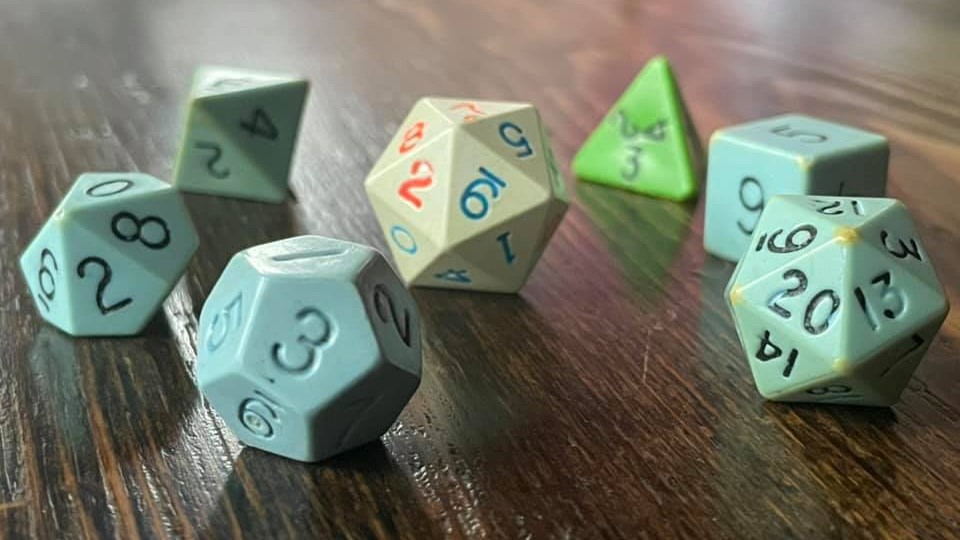We sat at a folding table in his room. He plopped a ragged denim bag on the linoleum tabletop, loosened the drawstrings, and dumped out a pile of dice.
As they clattered to a stop, I saw familiar white bone dice with dark pips, which must have come from a Yahtzee game, and clear red casino dice with white pips. There were big ones and small ones. Among them were dice of different colors. Blue, green, brown—the colors weren’t bright but drab, and they didn’t have pips but numbers.
The unfamiliar is often invisible. Under my eyes, there was something new in the world, and it took a moment for my consciousness to adapt. Jumbled up in the melee of plastic and pips and numbers were odd-shaped solids. These weren’t normal cube dice. Instead of squares, their faces were triangles and pentagons.
Garth said, “They’re polyhedrons.”
I picked one up. Holding it between thumb and forefinger, I turned it around. It was blue with black numbers. The corners and edges were worn and discolored, like a dingy sock. Each face was a pentagon.
“How do you roll it?”
“Like normal dice.”
“How do you know what number it is?”
“It’s the number on top.”
Rolling it in my palm, I couldn’t see any top. I dropped it on the table. One side showed a “3” flat up.
Garth reached for a dice. “This one’s different. It only has four sides.” He showed me a pyramid. “You have to toss it up and twirl it, like this.”
The dice spun in the air. He turned it around where it landed. “The numbers at the bottom of the sides are all the same. I rolled a four.”
He tapped the top point with a finger. “I call them caltrops. Don’t step on these.”

A full set of role-playing game dice, plus an additional d20, marked from 0 to 9 twice, each series with its own color. Photo courtesy of Kevin Greene of California’s Bay Area. An “old-school” gamer, Kevin began playing D&D in the sixth grade with these dice and Holmes Basic, Eldritch Wizardry, and the Monster Manual in 1982.
platonic body noun
variants: platonic solid
: any of the five regular geometrical solids comprising the simple tetrahedron, hexahedron, octahedron, dodecahedron, and icosahedronpolyhedron noun
pronounced ˌpä-lē-hē-drən
plural polyhedrons or polyhedra ˌpä-lē-hē-drə
: a solid formed by plane faces
A modern set of role-playing game dice consists of six polyhedrons. Each dice is used to generate random numbers from 1 to the number of faces—or sides—it has. In game parlance, they are known by this upper limit: d4, d6, d8, d10, d12, and d20.
Five of them, the four-, six-, eight-, twelve-, and twenty-sided dice are platonic solids. Despite the name, Plato did not invent them, but the regular geometrical solids figure in his philosophy. In Timeaus, he associated each of them with a classical element: tetrahedron (d4), fire; cube (d6), earth; octahedron (d8), air; icosahedron (d20), water. The dodecahedron (d12) Plato associated with heavenly constellations.
The ten-sided dice (d10), the only one of the set not a platonic solid, was added in 1980. It is an irregular-faced decahedron called a pentagonal trapezohedron. It is used to generate decimal numbers, most commonly 1 to 10 and 1 to 100, the latter range by rolling two dice, one each for the tens and ones places.
When a d10 is not available, a d20 is rolled and the tens digit ignored. Early d20s were numbered from 0 to 9 twice, one series being marked with a dot or colored differently—as the numbers on Kevin’s d20 are colored red and blue. To make this dice perform its d20 function, it’s rolled with a d6. A 4 to 6 on the d6, adds ten to the roll.
Pingback: Never Say Die – DONJON LANDS